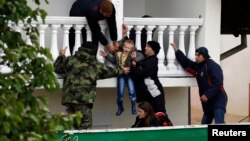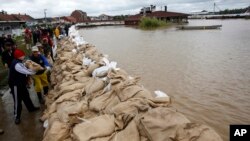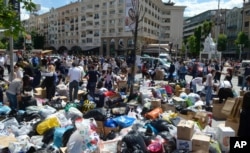Soldiers, police and volunteers battled to protect power plants in Serbia from rising flood waters on Sunday as the death toll from the Balkan region's worst rainfall in more than a century rose to at least 37.
Twelve bodies were recovered from the worst-hit Serbian town of Obrenovac, 30 kilometers southwest of the capital, Belgrade.
“The situation is catastrophic,” Prime Minister Aleksandar Vucic said, and warned that the death toll would likely rise.
About 300 landslides, triggered by unprecedented rains in Bosnia, have left thousands of people homeless, officials said Sunday, while thousands more have fled their homes in neighboring Croatia and Serbia.
Throughout hilly Bosnia, floods are triggering landslides covering roads, homes and whole villages. Stranded villagers often are being rescued by helicopter.
Three months' worth of rain fell on the region in a three-day burst, creating the worst floods since rainfall measurements began 120 years ago.
Russian cargo planes carrying boats, generators and food joined rescue teams from around Europe and thousands of local volunteers in evacuating people and building flood defenses after the River Sava, swollen by days of torrential rain, burst its banks.
Rains eased and flood waters receded on Sunday in some of the worst-hit areas of Serbia and Bosnia, but the River Sava was forecast to continue rising.
Pope Francis has asking the world to pray for victims of the flooding. In his weekly address at the Vatican he said that he feels personal closeness to those living through pain and trouble.
Power plants threatened
Serbia's EPS power utility said a fresh flood wave from the Sava and Mlava rivers threatened the Nikola Tesla and Kostolac power plants. Capacity has already been cut back at the Nikola Tesla plant in Obrenovac, Serbia's largest.
The Mlava overwhelmed sandbag flood defenses on Sunday morning near Kostolac, threatening to flood coal mines and the plant itself. Power plant workers joined soldiers and police in trying to divert the water, digging up a road in one area.
Villagers nearby were evacuated, many of them refugees from the 1990s wars in Bosnia and Croatia. Kostolac currently covers 20 percent of Serbia's electricity needs.
Flooding had already cut Serbian power generation by 40 percent, forcing the cash-strapped country to boost imports.
The economic impact of the floods is likely to be huge, devastating the agricultural sector vital to both the Serbian and Bosnian economies.
“These are the kind of waters not seen in 1,000 years, let alone 100,” Prime Minister Vucic told a televised cabinet session.
Officials say about a million people — more than a quarter of the country's population — live in the worst-affected areas.
The hillside village of Horozovina, close to the northeastern town of Tuzla, was practically split in two by a landslide that swallowed eight houses. More than 100 other houses were under threat from the restless earth. Residents told stories of narrow escapes from injury or death.
"I am homeless. I have nothing left, not even a toothpick," said one resident, Mesan Ikanovic. "I ran out of the house barefoot, carrying children in my arms."
Vucic said 12 bodies had been recovered from Obrenovac after waters dropped from a peak of some three meters. At least three more have been reported dead elsewhere in Serbia.
In Bosnia, 19 people were confirmed dead by Saturday, with nine bodies recovered from the northeastern town of Doboj after what the regional police chief described as a ``tsunami'' of water 3-4 meters high.
A Reuters cameraman at the scene said half the town was still submerged. Bosnian soldiers distributed food and medical supplies by truck, boat and bulldozer. Cranes lifted medical workers into the top floors of some homes and removed stranded residents from others.
Serbs forced from homes
Zeljka Cvijanovic, prime minister of Bosnia's autonomous Serb Republic, compared the devastation to Bosnia's 1992-95 war, in which 100,000 people died.
“The damage is such that we cannot recall even after the war,” she told reporters.
In Serbia, more than 20,000 people have been forced from their homes. Officials there fear more flooding later Sunday as floodwaters travel down the Sava and reach the country.
Serbian officials said that the flood level might be lower than initially expected, because the river broke barriers upstream in Croatia and Bosnia. Experts said they expect Sava floodwaters to rise for two more days, then subside.
In Croatia, the government said one person had died and two were missing in flooded Sava river villages in an eastern corner of the country near Bosnia and Serbia. The army used amphibious vehicles to help evacuate some 3,000 people.
‘I carried my kids out on my back, then waited 12 hours to be rescued myself,” said 40-year-old Obrenovac resident Dragan Todorovic, who spent the night in a Belgrade sports hall with dozens of other families. “The house was new, built two years ago for 100,000 euros. What now?”
Some information for this report was provided by AP and Reuters.
Twelve bodies were recovered from the worst-hit Serbian town of Obrenovac, 30 kilometers southwest of the capital, Belgrade.
“The situation is catastrophic,” Prime Minister Aleksandar Vucic said, and warned that the death toll would likely rise.
About 300 landslides, triggered by unprecedented rains in Bosnia, have left thousands of people homeless, officials said Sunday, while thousands more have fled their homes in neighboring Croatia and Serbia.
Throughout hilly Bosnia, floods are triggering landslides covering roads, homes and whole villages. Stranded villagers often are being rescued by helicopter.
Three months' worth of rain fell on the region in a three-day burst, creating the worst floods since rainfall measurements began 120 years ago.
Russian cargo planes carrying boats, generators and food joined rescue teams from around Europe and thousands of local volunteers in evacuating people and building flood defenses after the River Sava, swollen by days of torrential rain, burst its banks.
Rains eased and flood waters receded on Sunday in some of the worst-hit areas of Serbia and Bosnia, but the River Sava was forecast to continue rising.
Pope Francis has asking the world to pray for victims of the flooding. In his weekly address at the Vatican he said that he feels personal closeness to those living through pain and trouble.
Power plants threatened
Serbia's EPS power utility said a fresh flood wave from the Sava and Mlava rivers threatened the Nikola Tesla and Kostolac power plants. Capacity has already been cut back at the Nikola Tesla plant in Obrenovac, Serbia's largest.
The Mlava overwhelmed sandbag flood defenses on Sunday morning near Kostolac, threatening to flood coal mines and the plant itself. Power plant workers joined soldiers and police in trying to divert the water, digging up a road in one area.
Villagers nearby were evacuated, many of them refugees from the 1990s wars in Bosnia and Croatia. Kostolac currently covers 20 percent of Serbia's electricity needs.
Flooding had already cut Serbian power generation by 40 percent, forcing the cash-strapped country to boost imports.
The economic impact of the floods is likely to be huge, devastating the agricultural sector vital to both the Serbian and Bosnian economies.
“These are the kind of waters not seen in 1,000 years, let alone 100,” Prime Minister Vucic told a televised cabinet session.
Officials say about a million people — more than a quarter of the country's population — live in the worst-affected areas.
The hillside village of Horozovina, close to the northeastern town of Tuzla, was practically split in two by a landslide that swallowed eight houses. More than 100 other houses were under threat from the restless earth. Residents told stories of narrow escapes from injury or death.
"I am homeless. I have nothing left, not even a toothpick," said one resident, Mesan Ikanovic. "I ran out of the house barefoot, carrying children in my arms."
Vucic said 12 bodies had been recovered from Obrenovac after waters dropped from a peak of some three meters. At least three more have been reported dead elsewhere in Serbia.
In Bosnia, 19 people were confirmed dead by Saturday, with nine bodies recovered from the northeastern town of Doboj after what the regional police chief described as a ``tsunami'' of water 3-4 meters high.
A Reuters cameraman at the scene said half the town was still submerged. Bosnian soldiers distributed food and medical supplies by truck, boat and bulldozer. Cranes lifted medical workers into the top floors of some homes and removed stranded residents from others.
Serbs forced from homes
Zeljka Cvijanovic, prime minister of Bosnia's autonomous Serb Republic, compared the devastation to Bosnia's 1992-95 war, in which 100,000 people died.
“The damage is such that we cannot recall even after the war,” she told reporters.
In Serbia, more than 20,000 people have been forced from their homes. Officials there fear more flooding later Sunday as floodwaters travel down the Sava and reach the country.
Serbian officials said that the flood level might be lower than initially expected, because the river broke barriers upstream in Croatia and Bosnia. Experts said they expect Sava floodwaters to rise for two more days, then subside.
In Croatia, the government said one person had died and two were missing in flooded Sava river villages in an eastern corner of the country near Bosnia and Serbia. The army used amphibious vehicles to help evacuate some 3,000 people.
‘I carried my kids out on my back, then waited 12 hours to be rescued myself,” said 40-year-old Obrenovac resident Dragan Todorovic, who spent the night in a Belgrade sports hall with dozens of other families. “The house was new, built two years ago for 100,000 euros. What now?”
Some information for this report was provided by AP and Reuters.








